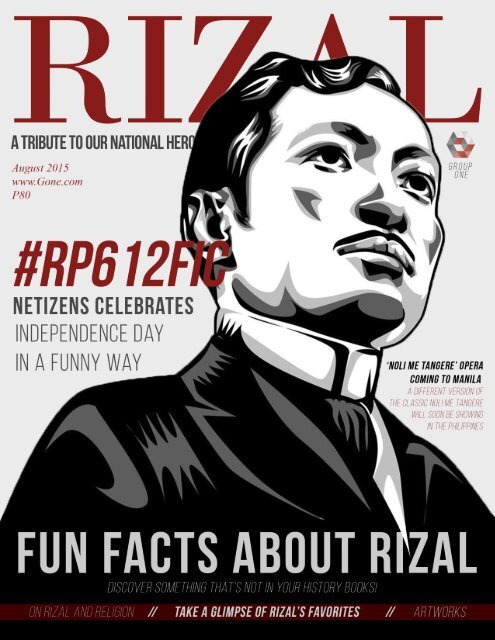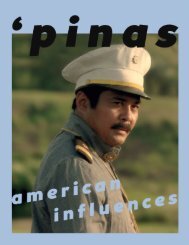Rizal
Rizal Histo Final Proj
Rizal Histo Final Proj
You also want an ePaper? Increase the reach of your titles
YUMPU automatically turns print PDFs into web optimized ePapers that Google loves.
contents<br />
5 - FACTS <strong>Rizal</strong> Fun facts 13 - On <strong>Rizal</strong> and Religion<br />
14 - A Glimpse of <strong>Rizal</strong>s Favorites 20 -<br />
ENTERTAINMENT Feature RP612fic<br />
30 - 5 Reasons why <strong>Rizal</strong> is just as human as the<br />
rest of us 36 - TRIBUTE Noli Me Tangere opera<br />
coming to Manila 37 - PHLPost exhibits <strong>Rizal</strong><br />
stamps, memorabilia 38 - Artworks
5
1. There are three<br />
animals named after<br />
<strong>Rizal</strong>. These species<br />
of animals were the<br />
ones he collected<br />
while he was an<br />
exile in Dapitan and<br />
include Apogonia<br />
<strong>Rizal</strong>i (Heller), a type<br />
of small beetle; Draco<br />
<strong>Rizal</strong>i (Wandolleck), a<br />
species of flying dragon;<br />
and Rachophorous<br />
<strong>Rizal</strong>i (Boetger),<br />
a species of toad.<br />
6 Facts<br />
2. Contrary to popular<br />
belief, the <strong>Rizal</strong><br />
monument in Luneta<br />
was not made by a<br />
Filipino artist. The design<br />
was the work of<br />
Swiss sculptor named<br />
Richard Kissling who<br />
won second prize in<br />
an art competition<br />
that was held in 1907<br />
to find the best scale<br />
model for the future<br />
<strong>Rizal</strong> monument. The<br />
first prize went to<br />
Italian sculptor Carlo<br />
Nicoli of Carrara but<br />
for some reason, the<br />
contract to build the<br />
monument was given<br />
to the second-prize<br />
winner.<br />
3. <strong>Rizal</strong> cured<br />
himself of tuberculosis,<br />
and was<br />
later recognized<br />
as a tuberculosis<br />
expert.<br />
4. He was already<br />
a terrific sculptor<br />
even at a very<br />
young age. In fact,<br />
<strong>Rizal</strong> carved a 9-inch<br />
statuette of the<br />
Sacred Heart out of<br />
batikuling wood when<br />
he was only 14 years<br />
old. The Jesuit fathers<br />
brought this statuette<br />
in Fort Santiago when<br />
they visited <strong>Rizal</strong> in<br />
December 1896. Aside<br />
from wood sculptures,<br />
<strong>Rizal</strong> also carved 40<br />
amazing masterpieces<br />
out of plaster,<br />
terra-cotta, wax, and<br />
clay.<br />
5. When he was<br />
studying in Spain,<br />
<strong>Rizal</strong> had to pawn<br />
a ring owned by his<br />
sister Saturnina just to<br />
pay for his exams. But<br />
he didn’t want his family<br />
to get worried, so<br />
he only mentioned his<br />
victories and excellent<br />
grades in the letters<br />
addressed to his family.
6. <strong>Rizal</strong> had psychic<br />
abilities. On his journal<br />
entry dated January 1,<br />
1883, he shared about a<br />
“frightful nightmare” he<br />
had two nights before<br />
(i.e. December 30). In<br />
this dream, <strong>Rizal</strong> was<br />
imitating a dying actor<br />
and felt his “breath was<br />
failing” and his vision<br />
became very dim. Interestingly,<br />
<strong>Rizal</strong> would<br />
be executed 13 years<br />
later at the exact same<br />
date. Austin Coates,<br />
<strong>Rizal</strong>’s biographer, also<br />
underscored that there<br />
were many incidents<br />
written in both Noli Me<br />
Tangere and El Filibusterismo<br />
that eventually<br />
happened to <strong>Rizal</strong> in<br />
real life.<br />
7. <strong>Rizal</strong> is regarded by<br />
many as the Father<br />
of Philippine Comics<br />
because of some<br />
humorous illustrations<br />
he made in Germany.<br />
The said drawing,<br />
entitled “The baptism<br />
of two brothers”, was<br />
inspired by the German<br />
cartoon “Max and<br />
Moritz” and was made<br />
by <strong>Rizal</strong> to entertain<br />
the children of his<br />
landlord, Pastor Ulmer.<br />
The original copy is<br />
now preserved in the<br />
National Library of the<br />
Philippines.<br />
8. According to Faustino<br />
“Tinong” Alfon,<br />
<strong>Rizal</strong>’s former cook in<br />
Dapitan, our national<br />
hero’s favorite fruits<br />
were lanzones and<br />
mangoes. His meals<br />
back then usually consisted<br />
of three kinds of<br />
ulam. <strong>Rizal</strong>’s breakfast,<br />
on the other hand, was<br />
usually comprised of<br />
hot chocolate, rice, and<br />
sardinas secas, commonly<br />
known now as<br />
simply tuyo.<br />
9. Mi Retiro is the<br />
name of his place of<br />
exile in Dapitan, was<br />
inspired by his favorite<br />
park in Spain, the<br />
Parque del Buen Retiro.<br />
10. He left specific<br />
instructions on how he<br />
wanted to be treated<br />
after his death.Here<br />
are some of his last<br />
wishes.<br />
Facts<br />
7
11. Only one of <strong>Rizal</strong>s skeletal<br />
remains was not buried under<br />
the monument in Luneta. A vertebra<br />
or a piece of the backbone<br />
where <strong>Rizal</strong> was allegedly hit by<br />
the bullet was claimed by his<br />
family and is now displayed in<br />
<strong>Rizal</strong> Shrine, Fort Santiago.<br />
12. <strong>Rizal</strong> stuffed unknown papers<br />
in his pockets and shoes on the eve<br />
of his execution. He did this, assuming<br />
that his corpse would be turned over<br />
to his family after the execution. But as<br />
we all know, his body was dumped by<br />
Spanish officials in an unmarked grave<br />
in Paco cemetery. The papers had since<br />
deteriorated, the contents of which<br />
were never identified.<br />
13. During <strong>Rizal</strong>s execution, a<br />
total of 8 Filipinos armed with<br />
Remingtons formed the firing<br />
squad. There were also 8 Spanish<br />
soldiers with Mausers behind<br />
them, ready to shoot the Filipino<br />
soldiers if they refused to execute<br />
<strong>Rizal</strong>.<br />
14. <strong>Rizal</strong> had a third, unfinished<br />
novel. Known among historians as<br />
“Makamisa”, this unfinished work<br />
was started by <strong>Rizal</strong> in Hongkong<br />
in 1892. Makamisa was not actually<br />
the title of <strong>Rizal</strong>’s work, but only<br />
the title of a single chapter of the<br />
unfinished Tagalog novel.<br />
8 Facts<br />
15. A descendant of one of the<br />
executioners, Adolfo Pastor<br />
Quetcuti, revealed that the captain<br />
of the guards put only one live<br />
bullet in one of the rifles, while<br />
placing blanks in the others. He<br />
explained that this is to ease their<br />
guilt as they already knew in the<br />
beginning that <strong>Rizal</strong> was innocent.
16. <strong>Rizal</strong> played a key role in<br />
the identification of Oncomelania<br />
cuadrasi, a Philippine snail<br />
that harbors the parasite that<br />
causes schistosomiasis. The said<br />
snail was named after a certain<br />
Mr. Cuadrasi, a known naturalist in<br />
Manila and to whom <strong>Rizal</strong> sent his<br />
specimens of animals and insects<br />
for identification.<br />
17. <strong>Rizal</strong> composed a farewell song for Leonor Rivera just before his<br />
departure for Europe. The song, entitled “Leonor”, became very popular<br />
“that many were heard singing it in the streets and during social gatherings. The<br />
moment they saw Leonor, the children would sing the song.” Here is the English<br />
translation of the song:<br />
And so it has arrived: the fatal instant, the dismal injunction of my cruel<br />
fate; and so it has come at last: the moment, the date, when I must separate<br />
myself from you.Goodbye, Leonor, goodbye! I take my leave, leaving behind<br />
with you my lover’s heart! Goodbye, Leonor: from here I now depart. O melancholy<br />
absence! Ah, what pain!<br />
18. “A la Senorita C.O. y R.”, one of <strong>Rizal</strong>’s<br />
best poems, was dedicated to Consuelo<br />
Ortiga y Rey, a pretty daughter of Don Pablo<br />
Ortiga whom <strong>Rizal</strong> fell in love with when he<br />
was in Madrid. However, <strong>Rizal</strong> backed out of<br />
the blossoming relationship because he was<br />
good friends with Eduardo de Lete who was in<br />
love with Consuelo. He also wanted to remain<br />
loyal to Leonor Rivera who would eventually<br />
marry Englishman Henry Kipping.<br />
19. <strong>Rizal</strong> once sent a love letter<br />
written in invisible ink to<br />
Leonor Valenzuela, a tall girl<br />
from Pagsanjan. The message<br />
could only be deciphered if you<br />
put the letter over a lamp or candle.<br />
Leonor Valenzuela was one<br />
of <strong>Rizal</strong>’s first sweethearts. Unfortunately,<br />
they parted ways<br />
when <strong>Rizal</strong> had to leave for Spain.<br />
20. While in Dapitan, <strong>Rizal</strong> wrote an extensive<br />
written discourse on kulam. Entitled “La curacion<br />
de los hechizados” (The treatment and cure of the<br />
bewitched), this lesser-known work of <strong>Rizal</strong> explores<br />
the psychological treatment for kulam and even explained<br />
that witches were not always women who are<br />
old or ugly. He also discussed the difference between<br />
hiloanon of the Visayas, who gives poison to<br />
her victims, and the manggagaway, the ‘traditional’<br />
witch who uses rag doll and pins.<br />
Facts<br />
9
21. <strong>Rizal</strong> was widely<br />
featured in cigarette<br />
wrappers. Most of<br />
these wrappers, made<br />
with Art Deco or Art<br />
Nouveau designs, were<br />
produced in Binondo<br />
during the turn-of-thecentury.<br />
An old cigarette<br />
label, Las Delicias,<br />
even went to the<br />
extreme by featuring<br />
<strong>Rizal</strong> smoking a cigar.<br />
22. <strong>Rizal</strong> was exceptional<br />
and prolific<br />
in a wide range of<br />
subjects–except music.<br />
This is because he<br />
already realized early<br />
in life that his singing<br />
“sounded like the braying<br />
of an ass.”<br />
23. Vital statistics:<br />
<strong>Rizal</strong> was about five<br />
feet three inches tall<br />
and had a waistline of<br />
about 25″ to 26″. He<br />
also had a big head:<br />
His hats were 6 1/2″<br />
across and the interior<br />
measures 8″ from front<br />
to back. He didn’t look<br />
odd, though, as his<br />
broad shoulders and<br />
developed neck compensated<br />
for it.<br />
24. It was rumored<br />
that both Adolf Hitler<br />
and Mao Zedong<br />
were the illegitimate<br />
sons of Jose <strong>Rizal</strong>.<br />
25. <strong>Rizal</strong>s original<br />
execution photo<br />
features a dog, the<br />
mascot of the firing<br />
squad. It is said that<br />
the dog ran around<br />
the corpse whining<br />
after a soldier fired<br />
one last shot in <strong>Rizal</strong>’s<br />
head to make sure he<br />
was dead.<br />
10 Facts
2<br />
On <strong>Rizal</strong><br />
and Religion<br />
Written By John Rhofil Icaranom<br />
to the article is quite simple: “Dahil Siya ang<br />
Pambansang Bayani “<br />
To mock someone elses religion is a very dangerous<br />
thing. Last January this year, the world<br />
is set a buzz when French Satirical Weekly<br />
News Magazine Charlie Hebdo<br />
was attacked by two gunmen.<br />
12 people were killed, 8 journalist,<br />
2 police officers, a caretaker<br />
and a visitor. The two<br />
gunmen killed five of France’s<br />
top cartoonists, saying that<br />
they wanted to avenge the<br />
prophet Muhhamad for Charlie<br />
Hebdo’s satire of him.<br />
According to an article published<br />
in the newspaper Philippine<br />
Star, barangay Ronggot in Calamba Laguna<br />
is dubbed as the <strong>Rizal</strong>ista Village. Barangay<br />
Ronggot is a bit out of the way according to<br />
the article. From Calamba proper, you have to<br />
take a bangka to get to the barangay, or the<br />
alternative is to walk about three or four kilometers<br />
on an unfinished, unpaved road. The<br />
barangay does not have a hospital or a public<br />
market, and the residents of the village have<br />
to go all the way to Calamba proper for the<br />
consumer items that they need.<br />
The reason for worshipping <strong>Rizal</strong> according<br />
When I found out that there is a group<br />
of people who worships <strong>Rizal</strong> as their<br />
second Christ, my initial reaction was<br />
to laugh. Really? What a really absurd<br />
practice I say. However, I’ve manage to<br />
urge the practice because of what I<br />
remember about the recent world events<br />
that transpired because of a lack of<br />
respect for other peoples beliefs.<br />
According to the article, the place has a shrine<br />
for <strong>Rizal</strong> with pictures and statues of the national<br />
hero, with the Ten Commandments believed<br />
to be penned by <strong>Rizal</strong> himself was said<br />
to be built. It is also said that the worshippers<br />
contend that <strong>Rizal</strong>’s spirit goes into chosen<br />
mediums so that he can continue teaching<br />
those who follow his ways. The medium nowadays<br />
is an old lady named Manang Gloria.<br />
There were others before her, but the story is<br />
the same for all of them. <strong>Rizal</strong>’s spirit supposedly<br />
possesses them during<br />
the time of worship, and<br />
through the medium, teaches<br />
his followers the lessons<br />
of living life the correct and<br />
righteous way. They say it is<br />
<strong>Rizal</strong> talking when the medium<br />
takes on the voice of a man.<br />
In a country that’s a haven of<br />
a lot of myths and folklores,<br />
it might not be really hard for<br />
those people to believe and<br />
do such practice. We have our own different<br />
beliefs, and I believe we don’t have to have<br />
the same religion beliefs to be able to genuinely<br />
care about each other, to do good to<br />
one another, besides all religion have a universality<br />
when it comes to their golden rules,<br />
“Hurt not others in ways that you yourself<br />
would find hurtful.” In the end it all comes<br />
down to you and your doings, if we’ve become<br />
good christians, muslims, rizalists or<br />
whatsoever, it’s all up to us. So yes, do good<br />
my friend. Do what you want as long as no<br />
one is hurting, it’s a free country anyways.<br />
Facts<br />
13
14 Facts
15
Facts 19
20 Entertainment
Entertainment<br />
21
22 Entertainment
Entertainment 23
24 Entertainment
Entertainment 25
26 Entertainment
human as th<br />
5 Reasons why<br />
Article written by Loren Rosaria<br />
30 Entertainment<br />
Heroes are human too; they<br />
laugh, they cry, they make mistakes.<br />
Jose <strong>Rizal</strong> was no different.<br />
To say he was an invincible<br />
champion who could do no<br />
wrong would be tarnishing the<br />
man <strong>Rizal</strong> was, for although he<br />
had his fair share of flaws, he still<br />
managed to overcome them all<br />
and become someone great.<br />
Rather than thinking of him as<br />
the ideal hero, let’s think of<br />
<strong>Rizal</strong> as someone who was<br />
just like us, yet persevered to<br />
become the great man we know<br />
him to be.
<strong>Rizal</strong> is just as<br />
e rest of us<br />
1. He Was A Bit Of A Grammar Nazi.<br />
While not as annoying as those you meet in online forums,<br />
Jose <strong>Rizal</strong> did have the tendency to correct people’s grammar from time<br />
to time, as exemplified in a letter he wrote to his young nephew, Alfredo.<br />
In the letter, <strong>Rizal</strong> corrected Alfredo on the phrase “I and my<br />
brothers greet you” (which the latter wrote in an earlier letter) and said<br />
the pronoun should have been placed after and not before the word<br />
“brothers.” For <strong>Rizal</strong>, it should have been “My brothers and I greet you”<br />
and added that many others would often commit that mistake.<br />
From a bigger perspective, <strong>Rizal</strong> also wanted to emphasize<br />
that people should place others first before themselves.<br />
2. He Was Stingy Yet Spent Regularly<br />
On Photographs.<br />
While living in Europe, <strong>Rizal</strong><br />
gained the reputation of a miser due to his<br />
extreme penny-pinching ways (he supposedly<br />
lived on only P50 a month).<br />
Before checking into hotels, he would always<br />
opt for a room without breakfast and<br />
instead use the savings to buy tea, biscuits<br />
and alcohol. He also rationed his portions<br />
painstakingly. In one incident, he and his<br />
roommate Jose Alejandrino agreed to<br />
split a box of biscuits between them for a<br />
month. The result? A starved Alejandrino<br />
finished his portion in only 15 days while<br />
<strong>Rizal</strong> managed to make his own last the<br />
entire month.<br />
Sometimes, <strong>Rizal</strong> would also<br />
neglect personal hygiene. In a letter to his sister, he revealed that he went<br />
without taking a bath for a long time because he found them too expensive.<br />
For all his stinginess, however, <strong>Rizal</strong> made sure to regularly allocate<br />
money for photographs. The number of photos we have of him today is<br />
proof <strong>Rizal</strong> loved taking pictures of himself.<br />
3. He Was Too Proud To Ask For Help.<br />
Despite his meticulous budgeting, <strong>Rizal</strong>’s financial situation did not always<br />
go smoothly. After his family’s estate in Laguna was subjected to a dispute,<br />
<strong>Rizal</strong>’s allowances became few and far between.<br />
Nevertheless, <strong>Rizal</strong>’s “Pinoy Pride” would never allow him to seek financial<br />
assistance from anyone. In fact, on the days he was broke and hungry,<br />
<strong>Rizal</strong> would often go out of his boarding house for a walk while cursing<br />
his bad luck.<br />
He would also go inside restaurants, take a whiff and go back home. Due<br />
to the smell of food on him, his companions would then assume he had<br />
just eaten out. Interestingly enough, American writer Ernest Hemingway<br />
also used this technique while he was living in Paris.<br />
4. He Experimented With Drugs.<br />
To be fair, <strong>Rizal</strong> was NEVER a drug addict. However, that did<br />
not stop him from trying some for the sake of science. While just an<br />
18-year-old, <strong>Rizal</strong> once used hashish he bought from a drugstore. At the<br />
time, the drug—a hallucinogen more potent than marijuana—could be<br />
easily bought over the counter along with cocaine, morphine and heroin.<br />
However, <strong>Rizal</strong> later justified his use of hashish in a letter he<br />
wrote to German scientist Adolf Bernhard Meyer,<br />
saying he just tried the drug for “experimental<br />
purposes.” Aside from hashish, <strong>Rizal</strong> was also<br />
known to use mustard plasters and sudorifics<br />
(drugs which cause sweating) to treat torticollis<br />
(“stiff neck”) when he was just a boy.<br />
5. He Was Torpe.<br />
Given the number of women who went in and<br />
out of his life, it would seem counterintuitive<br />
to think <strong>Rizal</strong> was “torpe.” Yet for the Don Juan<br />
that he was, <strong>Rizal</strong> experienced a case of cold<br />
feet in his liaison with his first love Segunda<br />
Katigbak.<br />
Although Katigbak was already engaged to<br />
be married to Manuel Luz, <strong>Rizal</strong> still fell for her<br />
anyway, describing her as “bewitching” and<br />
“alluring.” For the young lovers, it was love at<br />
first sight—one that would be doomed from<br />
the start, in part because of Katigbak’s engagement and because of<br />
<strong>Rizal</strong>’s indecisiveness.<br />
It happened like this: Sometime in December 1877 <strong>Rizal</strong> promised to<br />
escort the carriage carrying Katigbak when it passed by Calamba on<br />
the way to her hometown in Lipa. True enough, <strong>Rizal</strong> did show up riding<br />
a white horse and spotted Katigbak waving a white handkerchief to him<br />
from inside the carriage. Surprisingly, <strong>Rizal</strong>—instead of following the<br />
carriage—turned around and went home.<br />
While we may never know what spurred him to do so, <strong>Rizal</strong> certainly<br />
was heartbroken as could be clearly seen in his farewell poem dedicated<br />
to Katigbak:<br />
“Ended at an early hour, my first love! My virgin heart will always mourn<br />
the reckless step it took on the flower-decked abyss. My illusions return,<br />
yes, but indifferent, uncertain, ready for the first betrayal on the path of<br />
grief.”<br />
Entertainment<br />
31
35
PHLPost exhibits<br />
<strong>Rizal</strong> stamps,<br />
memorabilia<br />
Get to see original and never before seen<br />
<strong>Rizal</strong> stamps, artworks, love letters and<br />
other memorabilia of our national hero,<br />
Dr Jose <strong>Rizal</strong>!<br />
This is a press release from<br />
the Philippine Postal Corporation.<br />
To commemorate the 154th birth<br />
anniversary of national hero Dr<br />
Jose <strong>Rizal</strong>, The Philippine Postal<br />
Corporation (PHLPost), in cooperation<br />
with Tayabas Historical and<br />
Conservation Society will open the<br />
<strong>Rizal</strong> Stamps exhibit dubbed as<br />
“Mga selyo ni <strong>Rizal</strong>,” on Monday,<br />
June 22, at the Orlando Nadres<br />
Hall, Luis Palad National High<br />
School in Tayabas, Quezon province.<br />
Visitors will see all original<br />
and never before seen <strong>Rizal</strong><br />
stamps, artworks, love letters, and<br />
other memorabilia of Dr Jose <strong>Rizal</strong>.<br />
The exhibit will present, in chronological<br />
order, the old and latest<br />
issues in limited copies of the<br />
stamps with introductory texts.<br />
The exhibit will run until July 3,<br />
2015. Visitors will be charged a<br />
P10-entrance fee. The proceeds<br />
will go to the renovation of the<br />
Gabaldon school building at Luis<br />
Palad National High School.<br />
PHLPost also encourages students<br />
and the viewing public to participate<br />
in philately or stamp collecting<br />
by joining the Philatelic Youth<br />
Club. A starter kit, complete with<br />
application form, mini album, ID<br />
and P10 worth of stamps shall be<br />
available for those who want to<br />
join the stamp club.<br />
36 Tributes<br />
Meanwhile, the public will<br />
have the chance to try using<br />
the personalized stamps<br />
system to be installed in the<br />
exhibit area. They can now<br />
create their own photo stamps<br />
which can be used not only as<br />
a gift or souvenir, but also to<br />
mail letters. – Rappler.com<br />
Visitors will see all original<br />
and never before<br />
seen <strong>Rizal</strong> stamps, artworks,<br />
love letters,<br />
and other memorabilia<br />
of Dr Jose <strong>Rizal</strong>.
‘Noli Me Tangere’ opera<br />
coming to Manila<br />
MANILA, Philippines<br />
– A different<br />
version of<br />
the classic Noli<br />
Me Tangere will<br />
soon be showing<br />
in the Philippines<br />
– this<br />
time, in opera<br />
form.<br />
The intimate gathering held last week, hosted<br />
by director Freddie Santos, gave audiences a look at the<br />
production. Guests were regaled with the powerful voices<br />
of local opera group Primo Vera. The venue was also<br />
abuzz with eager anticipation for the main event: songs<br />
performed from the original opera.<br />
Ms. Loida Nicolas Lewis, the mastermind behind<br />
the bringing of the opera to the Philippines, was also in<br />
attendance. Through the passion and dedication of Lewis,<br />
along with executive producer, costume and set designer<br />
Jerry Sibal, and assistant executive producer Edwin Josue,<br />
Manila will soon have the pleasure of seeing a classic story<br />
from Philippine history retold through a different medium.<br />
The story of Noli is one that Filipinos know all too well,<br />
from Crisostomo Ibarra’s discoveries after his return to<br />
the country, the sad fate of the unfortunate Sisa, to the<br />
truth about Crisostomo’s love, Maria Clara. Set in the<br />
Spanish occupation, <strong>Rizal</strong>’s novel tells of the cancer that<br />
plagued society, and what actions can spark a revolution<br />
for change.<br />
This operatic rendition breathes new life into Jose<br />
<strong>Rizal</strong>’s masterpiece. “It’s an opera made in the same spirit<br />
of Verdi, of Puccini, of Bernini. Grand opera in the Italian<br />
style,” Lewis said. The difference? It is sung entirely in Filipino.<br />
The brainchild of two national artists, the Noli opera<br />
boasts music composed by Felipe de Leon and libretto by<br />
Guillermo Tolentino.<br />
Lewis first had the idea to bring the production<br />
to New York after attending the 100-year celebration of<br />
Felipe de Leon in Chicago last year.<br />
“They were singing in Tagalog and napakaganda. (It was<br />
so beautiful.) It touched my heart, and I said, ‘This cannot<br />
stay in Chicago. I have to bring it to New York because if<br />
it didn’t happen in New York, it didn’t happen,’” she says.<br />
And so it happened. Lewis, Sibal, and Josue successfully<br />
staged the Noli Me Tangere Opera in New York. It sold out<br />
all the three days that it ran, and was even reviewed by<br />
the New York Times.<br />
The opera intends to showcase the world-class<br />
talent of its Filipino cast. From the moment director Freddie<br />
Santos introduced the first performance by the ensemble<br />
from the US production, guests were immediately<br />
treated to the unique feel of the opera, from the traditional<br />
costumes to the fluid lyrics in Filipino. Noteworthy also,<br />
was the solo performance of soprano Kirby Asunto, who<br />
played the pivotal role of Basilio, Sisa’s son.<br />
Noli Me Tangere Opera will once again play out<br />
on Philippine stage in September<br />
2014 at Resorts World Manila’s<br />
Newport Performing Arts Center.<br />
Freddie Santos will direct, with<br />
Camille Lopez Molina at the helm<br />
as vocal master. The team will stage<br />
21 straight shows, a feat unheard of<br />
in the opera world.<br />
“This cannot be done with<br />
the same cast every night,” Santos<br />
says, “The amount of actors coming<br />
from abroad is very minimal.” With<br />
plans to have two alternate groups<br />
of 40 actors each, the team is in<br />
search of more talent. Open auditions<br />
will be held on May 2 (4pm),<br />
and May 3 (11am). Actors must<br />
come prepared to sing an aria from<br />
the Noliopera, or an aria of their<br />
choice if they are unfamiliar with<br />
songs from the production.<br />
With the Philippines soon<br />
to be checked off the list, the team<br />
will next stage the production in<br />
Washington, D.C.’s Kennedy Center.<br />
“It is now high time that the Philippines<br />
take its proper place,” Lewis<br />
explains, “We are not only economically<br />
no longer the sick man of<br />
Asia. We are the new tiger, but we<br />
have to show the world that we are<br />
also world class artists.” Sibal adds,<br />
“We are trying to put this Noli Me<br />
Tangere Opera in the world so that<br />
the international opera companies<br />
could adapt this and present this all<br />
over the world.” – Rappler.com<br />
Tributes<br />
37
38 Tributes<br />
Artw
orks<br />
Made by Lester Absulio<br />
Tributes<br />
39
40 Tributes<br />
Supposed to be the Cover<br />
Edited by<br />
Mariel Verano







